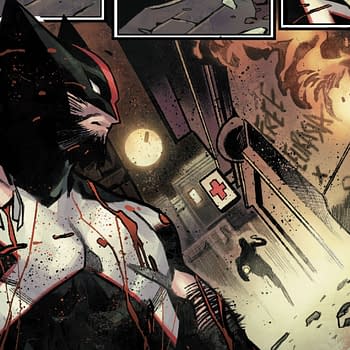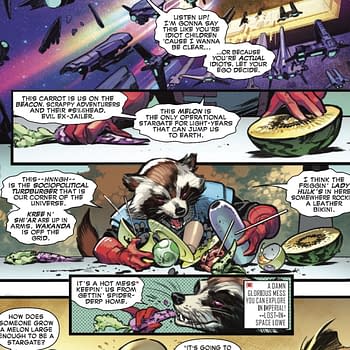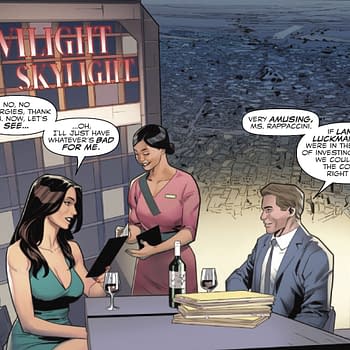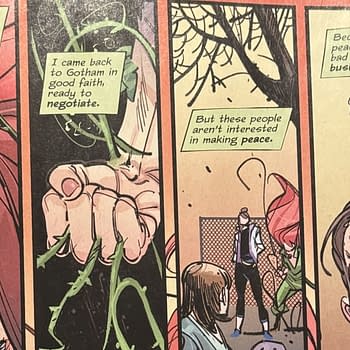Posted in: Comics | Tagged: archaia, Comics, entertainment, Godzilla in Hell, Long Walk to Valhalla, Marvel Comics, Secret Wars
Thor's Comic Review Column – Godzilla In Hell #1, Captain Marvel And the Carol Corps #2, Long Walk To Valhalla, Guardians Of Knowhere #1, Captain Britain And The Mighty Defenders #1, Hawkeye #22, Secret Wars: Siege #1, Secret Wars: Hail Hydra #1
This Week's Reviews:
Godzilla in Hell #1
Captain Marvel and the Carol Corps #2
Long Walk To Valhalla GN
Guardians of Knowhere #1
Captain Britain and the Mighty Defenders #1
Hawkeye #22
Secret Wars: Siege #1
Secret Wars: Hail Hydra! #1
Godzilla in Hell #1 (IDW Publishing)
By Bart Bishop

So the premise is amazingly simple: Godzilla goes to hell, and it's trippy. How did he die? A quick Google search comes up with nothing, so I'm assuming this is a standalone adventure not reliant on any prior series. I also believe this continues from the Millenium era Japanese canon, but again even those were only loosely connected. So the original kaiju falls for what seems like forever, only to find himself in Dante's vision of the Inferno. In a nice little touch, he encounters the famous epitaph, "Abandon All Hope Ye Who Enter Here" and promptly burns it to the ground. The Big G is not impressed and stomps his way through this otherworldly landscape, bumping up against Lovecraftian monstrosities, swarms of damned souls, and finally a scarred doppelganger. Brute force, tenacity and lots of fire breath help him brave the day, but he's not home-free yet.
There's an existential question at the very core of this endeavor, and that is: does Godzilla have a soul? He's a mutated, monstrous being after all, but sentient. I only ask because the parallels with Dante and the presence of humans certainly imply this is a traditional hell where people are cast down, although it abides by a purely physical, cavernous conception. That's appropriate, however, considering how much of a locomotive Gojira himself is, and how tactile at least the earlier movies were, even if CGI is now the dominating factor. Furthermore, what did Godzilla do to deserve such a fate? He's not "evil" exactly, more a force of nature, and in several versions he's a hero of sorts when pitted against worse foes (in sillier versions, he's a straight-up champion). What more is there to say about Stokoe's writing? He certainly understands how Godzilla would react under these circumstances, and that is to oppose everything in his way.
I once had a debate with a friend on whether or not Godzilla is a science fiction concept. It's easy to chalk up the original movie as a sci-fi story as it involves man's hubris, that being the atomic bomb, and its fallout. Sci-fi, after all, is the best medium for allegory. A story like this, however, is a good example of why I think of the character as more fantastical. Stokoe pulls double duty, and the art is gorgeous in both rendering and imagination. Godzilla looks right, fierce and obstinate in a way that's a blast to sympathize with. I mean, no matter how many buildings he's stepped on, hell has got to suck. The nether-realm is given a few dissonant modern touches, such as the nuclear power plant silos that grab Godzilla's attention, but mostly it's what you'd expect: endless, underground, fire and brimstone. But there's nothing wrong with the platonic form of a classic setting, just like Godzilla himself is a pure, unadulterated version of himself that could really be any of them. Either way, Stokoe knows what he wants and it's a lot of crazy nightmares tearing each other apart.
Not exactly thematically rich or intellectually challenging, but Godzilla in Hell isn't aiming for that. It's tapping into something purely visceral and primordial in its fears, and answers the question of escalation when it comes to a King of Monsters that's conquered everything in his path.
Editor and teacher by day, comic book enthusiast by night, Bart has a background in journalism and is not afraid to use it. His first loves were movies and comic books, and although he grew up a Marvel Zombie he's been known to read another company or two. Married with a baby daughter, he sure hopes this whole writing thing makes him independently wealthy someday. Bart can be reached at bart.bishop@cincinnatistate.edu and on Twitter @BartLBishop.
Captain Marvel and the Carol Corps #2
By Adam X. Smith

So yeah. That's a thing.
As in Kelly Sue DeConnick's previous run of Captain Marvel, there's some pretty much instant chemistry between Carol and Rhodey, who essentially doesn't do a lot apart from requiring medical attention that can only be provided on the QT by a sympathetic base doctor, and provide backstory as to why he was there and that he is determined to find out who blew up his ship.
Oh, the drama.
With her previously stated goal to find out what's really on the other side of the sky meaning not just insubordination but also heresy, the Carol Corps are forced to hastily convert their jets into rockets capable of spaceflight using whatever spare parts they can lay their hands on. Mack manages this, but a test-flight is required to make sure they've ironed out any kinks. Hot-headed maverick Pancho thinks they should do it straight away since delay will only increase the risk of them being caught, but Carol orders her to wait until morning.
You don't have to be a literary scholar to figure out what happens next: Pancho disobeys, and her bird explodes on take-off, right in front of Carol's eyes. Having already had the doctor literally tell her that they were going to get themselves killed, and Baroness Cochrane's chess reference to sacrificing oneself for a bigger cause, there was ample foreshadowing that one of the Carol Corps members would face being offed in the name of raising the stakes. Mercifully, David Lopez' final page emphasises the tragedy without making it unseemly. The story has elements of classic movies like Top Gun and The Right Stuff but with subtle references to WWII prison-break movies like The Great Escape – even the subplot of Rhodey as an injured outsider secretly being nursed back to health and acting as a catalyst for Carol's decision to escape Hala Field is essentially the plot of Chicken Run played straight. Not a criticism by the way.
What is clear is that the stakes are pretty high – the cost of failure is either death or imprisonment, and now Carol has the death of a comrade on her conscience. Will her resolve waver? Are any of the Carol Corps going to make it out alive? And who is Baroness Cochrane anyway?
Seriously, I want to know.
All this and more in the next issue of Kelly Sue DeConnick and Kelly Thompson's Captain Marvel and the Carol Corps, folks. Same Marvel-time, same Marvel-channel.
Adam X. Smith thinks that this is a little on the short side, but he's supposed to be going to see a documentary about the Hellraiser movies tomorrow and he still hasn't seen Ant-Man yet. He's also got a bunch of other articles to write for @ElectrolyeMag, including one about the Wilhelm scream and one trying to make sense of the logistics of American TV for a British audience. Look grateful.
Long Walk To Valhalla GN (Archaia, $24.99)
By Cat Taylor
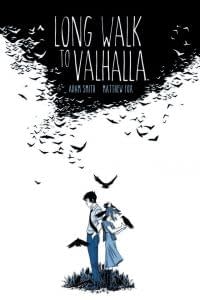
The creators, Adam Smith (writer) and Matthew Fox (artist) are both fairly new creators but have gotten their careers off to a stellar start, previously working together on the critically-acclaimed UFOlogy. For this, their first original graphic novel, they have created a story that is tonally along the lines of the movie Breakfast Club, without the music and dancing, and the comic Ghost World, if Ghost World were a small town Southern folk tale rather than an iconic independent comic for the generation X alterna-crowd. However Smith does hit that generation X/alternative vibe by having a character name-check the Dead Milkmen and Kathleen Hannah, which seems really out of place for the characters in a story about a small Southern town, but everyone has the internet nowadays so it's not entirely implausible that one of these characters would be familiar with those performers.
At any rate, Long Walk To Valhalla is about a guy named Rory who is finally leaving behind his hometown and all the headaches that came with living there, including a drunk and possibly abusive father, a seemingly mute and "intellectually challenged" brother, and other deeply buried tragedies that come out later in the book. Rory's plans are delayed due to engine trouble and an encounter with a little girl named Sylvia who claims to be a Valkyrie. From there, it's kind of a This Is Your Life as she gets him to discuss events of his life and to see them in a new light or, in some cases, even acknowledge that they happened. Although the events in Rory's life are a lot sadder than I've personally experienced, it wasn't difficult to put myself in Rory's place and think of depressing situations that I've handled poorly as well as those where someone made me stronger simply by caring or believing in me. Therefore, I found the story to be relatable and emotionally touching. It also helped that the character of Sylvia was a lot of fun. She's written with the personality of a precocious child who is smarter than her age, funny, and a bit of a smart-ass but still comes off like a kid having fun at times, and the best counselor you could ever want at others. The other characters have a bit less depth, especially Rory's father who is the cookie-cutter drunk redneck from every movie you've ever seen, but somehow that didn't seem to be a weakness to the overall tale.
In addition, Fox's art works well for this book. It's a throwback to the independent comics of the 1990s like Eightball and Love and Rockets. The style is simple and cartoony but not comical. Fox also really took to the character of Sylvia by conveying as much of her personality through her facial expressions and movements as Smith does with her words. Also of note, the color choice for this story is unusual. It would be a black and white book except that varying shades of blue are used for every color that isn't black or white.
Comics have come a long way since the days when you had to show someone a copy of Maus or American Splendor to prove to a non-comic book reader that comics weren't all just about superheroes, and that some comics are as good as a lot of books and definitely better than most television dramas. I'm sure we could all come up with a pretty lengthy list of non-superhero comics that we would recommend. While I don't know how long my list would be, I now know that Long Walk To Valhalla would be on it.
Cat Taylor has been reading comics since the 1970s. That's all he's ever done. He's still reading them, even as he writes this. Is that a world record? I mean, when does he get time to eat and use the bathroom? Does he ever shower? And why does he refer to himself in third person in these bios? If you have any answers to these questions, you can e-mail him at cizattaylor@hotmail.com.
Guardians of Knowhere #1 (Marvel, $3.99)
Captain Britain and the Mighty Defenders #1 (Marvel, $3.99)
By Graig Kent
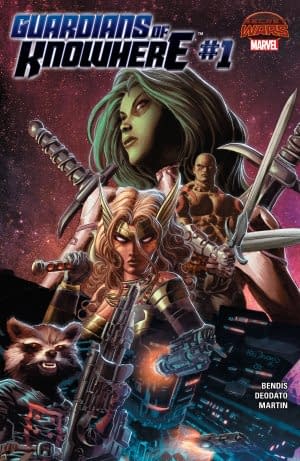
Featuring a broad swath of Marvel's pantheon, including multiple varieties of the same character in all sorts of high-concept situations (perfect for a short mini-series run but perhaps unsustainable in the longer-term) from some rather exceptional creative teams, the books theoretically should be new-reader friendly and somewhat stand-alone. Picking up Thors #1 and Civil War #1 in the past month, I've found that to be true, but with Guardians of Knowhere #1 and Captain Britain and the Mighty Defenders #1 this week, I'm feeling a tad left behind.
Both books rely upon a rudimentary understanding of what Battleworld is, how it came to be and an awareness of Doctor Doom's role as ruling deity over it all. Both books find some of the characters coming to realize the falsity of their surroundings, understanding that Doom is not a god but a man, and that he's manipulated their reality. In Guardians it's Gamora, while in Captain Britain it's Dr. Faiza Hussein, wielder of Excalibur and the moniker of Captain Britain.
Guardians opens with Drax having it out with Angela in a four-page fight sequence (actually it opens with gorgeous splash pages rendering the epic scope and scale of Knowhere, the city inside a Celestial's head). Angela seeks Gamora, since she's left her territory, which is forbidden. Reading it on its own, I had no idea what that meant. Why is Angela so concerned with Gamora leaving Knowhere? What does it matter?
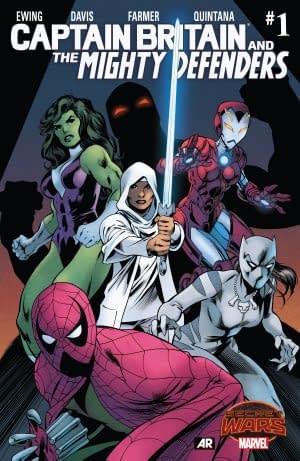
It's only through my reading these two books back to back that I gain a better sense of the state of this "Battleworld", and the rules that govern it. Doom has made it clear that nobody shall leave their realm (lest the realms start colluding against him, I presume), and (adding in details from my reading of Thors #1 a few weeks back) it's the Thors who are Battleworld's police force. It's only in this writing that I realize that Angela in Guardians of Knowhere is a Thor, seeking Gamora for breaking Doom's law.
I'm sure any reader of Secret Wars has all these details in hand, but as an outsider stepping in, it's a bit of a chore to suss out the meaning behind most of the conversations in these books, and to understand the rules that govern them. Since each of these books features a title page that explains in brief just what's going on with Secret Wars, it could stand to elaborate on relevant details for the story (like how a serialized TV show like Mad Men or Game of Thrones will provide a brief recap to highlight aspects that will be relevant to the story at hand). Just noting for Guardians that the Thors are the police enforcing Dooms strict policy of not travelling between realms would have helped tremendously. Likewise for both books, noting that in the remaking of reality, Doom has manipulated the memories to recall only what he deigns important would be a helpful touch (though Captain Britain gets to the gist of that effectively).
While both books touch upon its protagonists coming to the realization that they're living a lie, Captain Britain ends with what should prove a heavy distraction from exploring that realization, as writer Al Ewing introduces (or perhaps reintroduces?) the Marvel Universe's answer to Mega City 1 with Mondo City. Likewise Boss Magniconte finds Magneto in the Judge Dredd role with Boss (Emma) Frost looking very Judge Anderson-esque. Over in Guardians, writer Brian Michael Bendis seems to have the clout within Marvel to make his story a more integral part of the Secret Wars agenda, as Gamora seems to be a key to unlocking this reality as a daughter of Thanos ("Who's Thanos?", they ask). Yet by the end they too seem to be distracted by yet another behelmeted assailant, Yotat, the Destroyer of the Destroyer (a guy with real beef with Drax).
With Alan Davis and Mark Farmer illustrating Captain Britain and Mike Deodato on Guardians you know both of these books are looking good. Davis seems to be having fun with the character twists in his story while Deodato gets to do a little bit of everything on his side, bringing a wonderful Heavy Metal-esque sci-fi feel to Knowhere.
I like that Captain Britain has an effortlessly diverse cast, one which calls no attention to itself, and conveys a unique sense of legacy among almost all its characters, but the story overall is bland. Likewise with Guardians. There's a sameness to both books that reminds me (somewhat traumatically) of DC's recent Convergence event, and how the story beats became so commonplace and tedious among most of the titles, and a dawning realization that the tie-in books had negligible impact on the larger event (or even the characters) at hand. I have only read a small handful of these Secret Wars , and it's not been as dire as Convergence, thankfully, but still it's something that will keep me wary of pursuing further tie-ins.
Graig Kent was a broken man after covering Convergence for 8 weeks straight. He took a little break and threw his little girl a wicked Star Wars themed birthday party with a rad homemade Death Star pinata. . He tweets sometimes @thee_geekent and does other stuff elsewhere.
Hawkeye #22 (Marvel, $3.99)
By Jeb D.
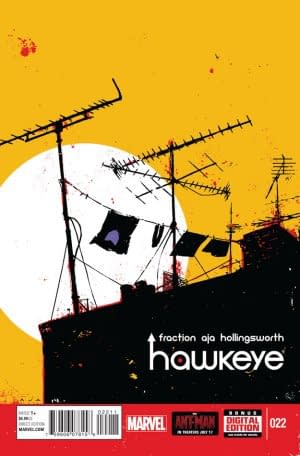
That said, there's a gutpunch quality to this issue that would have hit just as hard had it come in "on time." Clint, Kate, and Lucky have their final showdown with the assassin known as the Ghost, and the tracksuited East European thugs, and it's a brutal fight, one that for the most part eschews Aja's clever visual touches in favor of action that feels painful, and savagery that feels earned (it's actually startling when, at a climactic moment, Aja uses one of his little infographics to give us a key piece of information). Matt Hollingsworth's color palette is, as always, evocative and definitive.
No one following the series up to this point is going to pass up the chance to see how it ends, but Fraction and Aja don't take that for granted: if this issue lacks the wry humor of Kate's encounter with "Elliot Gould," or the visual cleverness of Lucky's classic "Pizza is my Business" story, it provides enough sharp dialog and unexpected twists to go along with the ferocity and sadness (my favorite touch is the callback to one of the few words Lucky was able to comprehend: "stay").
My only real reservation is that Fraction's attempt to make Clint as well rounded as possible too often means evoking whichever side of his personality (amiable, goofy, resourceful, passionate, self-deprecating, self-aggrandizing, etc.) will get him in the most trouble in a given situation; across several issues at a time it's not a problem, but it does get a bit blatant here, as though Fraction wanted each of Clint's personality quirks to take a final bow. There's also a "post-credits" scene that teases a storyline we'll probably never see (and that I half suspect was set up for precisely that reason). Hawkeye #22 is about as self-recommending as it's possible for a Marvel comic to be, but for what it's worth, I'll recommend it anyway, in the highest possible terms.
Secret Wars: Siege #1 (Marvel, $3.99)
Secret Wars: Hail Hydra! #1 (Marvel, $3.99)
By Jeb D.
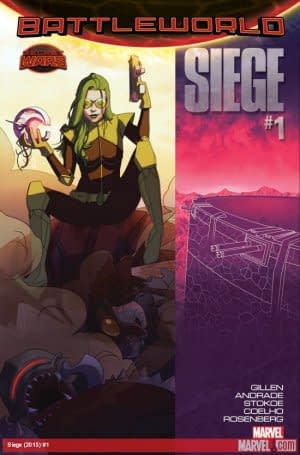
Kieron Gillen's Siege joins this week's Captain Marvel and Captain Britain books in widening the cracks in Doom's mythology. There's a lot of storytelling involved in the avalanche of Secret Wars tie-ins (and I doubt I've read half of them), but one way or another, most of them are inevitably going to have to reach this point (well, maybe not Where Monsters Dwell—that book is getting more Ennis by the issue, and I have no clue if he even knows that Secret Wars exists). As with much of Secret Wars, some of the impact of that development is muted when we've already seen so much of the endgame (or, at least, its results) in solicitations and promos, with much more to come (it's particularly problematic since it appears that the Secret Wars delays will present us with a new status quo before some of these series wrap up).
Abigail Brand is a watcher on Doom's wall (er, Shield), attended by such factotums as rogue shieldmaidens, "Lady Kate" Bishop, The "Endless" clan of Summers, Leonardo DaVinci, and The Thing (who evidently composes part of the Shield himself). While she's seen zombies and Ultrons, the perils she faces in this issue are truly bizarre, particularly the grotesque Giant Ant Men, who take that melding of Henry Pym's two key personas into a horrifying direction, amazingly depicted in a two-page spread by James Stokoe. Jorge Coelho also provides a two page spread, but the main artist for the issue is Filipe Andrade, who enlarges on the fluid weirdness and exaggerated character work he brought to Captain Marvel; it's a more visually-exciting comic than you might expect for what is a pretty exposition-heavy issue.
Abigail's backstory runs into some chronological oddities (a breach of the shield that took place "thirty years ago" is alluded to), which may be explained by her confrontation with Kang (one of the most entertaining versions of the character I've seen), reminding us that Doom's not the only character capable of screwing with the Marvel timeline (to say nothing of the character whom Kang is warning her about: "Who's Thanos?" Abigail demands). Fans of Gillen's Young Avengers may miss the coolly modern visual touches of Jamie McKelvie, but this cast of characters rewards Andrade's explosive energy. And lemme tell you, those Giant Ant Men will give you nightmares.
Hail Hydra! is one of the few Secret Wars titles that follows pretty directly out of an existing Marvel series: it's the further adventures of Ian (Nomad) Rogers, the son of Arnim Zola, adopted by Steve Rogers in an alternate reality, the central character in Rick Remender's All-New Captain America. This issue jumps off more or less directly from that series, as we follow Nomad's disoriented descent into the Infinity Elevator to find a world dominated by a victorious Hydra. More than anyone since, Remender's time with Captain America has harkened back to the madcap days of Jack Kirby's writer-artist turn on the character, in visual elements like Nomad's mad dash through the streets, Hydra agents in flying pursuit, and his finally meeting up with the nightmare version of himself. Artist Ronald Boschi brings the same action-movie intensity he's shown before on Ghost Rider and The Punisher. Remender rings some interesting changes on the lone-hero-in-future-dystopia, and it's a shame this is the last we're likely to see of his Nomad: as one of Cap's various alternate identities, the original Nomad felt starved for a purpose that Remender remedied with his adopted son.
Jeb D. is going back Into the Woods this week. Pray for him.










